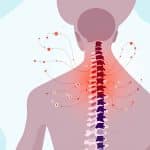Ever wake up and feel like a clumsy robot, your neck stiff and unyielding? You’re not alone. It’s like your neck had a secret gym session while you were catching Z’s. Well, welcome to the neck pain club—population: many. This all too common niggle can wreck your day faster than Monday morning traffic.
But hey, no need to check if it’s permanent stiffness induced by sleeping weird. The answer often lies in a delicate dance of keeping your muscles balanced and yes, hormone regulation can significantly affect this. Trust me, we’ll unravel these layers together and look at how hormone swings can wreak havoc or that bothersome neck zone.
Why Is Neck Pain, and Its Balance, So Relatable?
Staying glued to our screens or hanging in dubious posture positions (slumped on sofas like abstract art) does a number on our skeletal support system. Plus, add stress hormones thrown into the mix – it spices things up a bit, doesn’t it? So, whether you nodded a bit too vigorously during that boring Zoom call or overdid your workout fuselage, here’s how we can counteract.
Understanding Hormone Regulation and Its Role in Neck Health
There’s more to neck aches than just poor posture and overworked muscles. Did you know? Hormones play a surprising role! They dictate how inflammation and pain radiate through your body.
Hitting That Hormonal Balance
- Cortisol: The Stress Alarm Bell – This hormone gears you up for “fight or flight,” which for neck muscles could mean tension central. Learn to bring it under control with heart-pumping workouts, calming meditation sessions, or even swapping those endless coffee cups for herbal teas. Minerals like magnesium can soothe relations with a stressed head.
- Estrogen and Your Muscles – More than just a gender hormone. Estrogen can offer anti-inflammatory effects which can directly or indirectly soothe neck pain. Keeping good levels often helps muscle flexibility and strength among many other things. So yes, gents, estrogen ain’t just a women’s monopoly.
- Testosterone: It’s All About Muscle Mass – Low testosterone can leave muscles saggy and less robust. Consider strength training tailored to a neck-friendly routine or eating muscle-building foods. Nutritional balance equals hormone balance!
Quick Guide: Breaking Free from Neck Pain

The journey to neck freedom is not about quick fixes but sustainable hacks. Consider these top practices as moves in your injury-prevention playbook:
- Neck Exercises – Ease into gentle neck rotations and stretches. Begin like you’re saying “no” and “yes” with deliberate nods.
- Mind Your Posture (Seriously) – It’s a gentle nag; straighten that spine, let shoulders drop, and elevate your screen to eye level. Seems almost trivial, right? Wrong. I swear, it’s neck-ache kryptonite.
- Ergonomic Checks – Your workspace shouldn’t resemble a torture chamber. Check factors like your desk height and chair support. Large screen creens? Get them doubled for added incentive.
- Regular Massage Power – Who says no to some TLC, especially with gym-tight muscles? Massage invigorates blood flow and dissipates bunched-up knots. You might find that a scented candle truly soothes more than just your senses.
Holistic Approaches: Give These Tried-and-True Methods A Try

Let’s dive into some less talked about things that deserve their space in our muscle-care routines:
- Mind-Body Synergy: Practices like yoga or tai-chi encourage flexibility and awareness—hello, improved posture. Suddenly, rolling out that mat doesn’t seem so bad!
- Seafood: Omega-3s Add Spice – These wonderful fats (find them in your favorite fish) are powerhouses in reducing inflammation, indirectly supporting muscle harmonizing and comfort.
- Warm Epsom Salt Bath – This warm hug for your muscles can balance the effects of tension and stress. It’s like marinating yourself into zen. Try it today!
- Calcium and D Extravaganza – Calcium supports muscle function and Vitamin D aids in its absorption. So, root for your bold cheeses and vitamin-rich sunshine walks.
Hormone-Friendly Foods List
Since we dipped into hormone chatter before, here’s a roll-out list to pump that up:
| Hormone | Go-To Foods |
|---|---|
| Cortisol | Nuts, Seeds, Avocado |
| Estrogen | Soy, Flax-seeds, Broccoli |
| Testosterone | Eggs, Leafy Greens, Oysters |
Overcoming Hormone-Induced Neck Trouble Through Lifestyle Changes

Heard of too much of a good thing? Precisely. Even healthy workouts have recovery periods, promoting body balance rather than cortisol uproars.
- Prioritize Sleep – Easy, free, and essential. Reinvent your nights with perfect darkness, electronic-can’t-reach zones or nature sound apps. Refreshing weariness away resets your hormonal hullabaloo.
- Laugh More – Yes, chuckle as you stretch. Emotional wellness through laughter diminishes the need for stress aliens knocking in.
- Say No to Excess – Moderation remains fixed. Balancing act puts a halt to abandon, especially with foods or activities leading to hormonal spikes/dips.
**So to circle back…** neck pain and hormones aren’t fancy buzzwords for sleep studies. Rather, understanding this well-oiled partnership can beat crippling neck issues to the curb. A balanced lifestyle filled with wholesome habits, tuned-in posture, and hormone allies is worth the effort. It’s about balance, like everything else that truly works.
Last Takeaway: Let’s Recap
- Neck Exercises: Start mild, keep consistent.
- Mind Posture & Ergonomics: Adjust, adjust, and adjust again as is necessary.
- Mind-Body Bits: Dive into ancient practices for lasting benefit.
- Balanced Food Intake: Focus on aiding hormones.
- Embrace Laugh and Sleep: Vital yet often brushed aside.
Ultimately, neck rehab isn’t a quick sling from your collar. It intertwines factors from movements to hormone regulation, influencing muscles often clandestinely.
So dear reader, as we draw to a close here, breathe into that stretch, measure that stance, or indulge in mussel-fancy shellfish next meal. Send me updates! I’m winding down my own neck tine regimen tomorrow. Better in that balance bandwagon!
Frequently Asked Questions
What causes a hormonal imbalance?
A hormonal imbalance can be caused by natural changes or stages in life, such as puberty, pregnancy, perimenopause, and menopause. Other factors include genetics, aging, increased daily stress, and certain medical conditions like tumors, adenomas, or autoimmune diseases[3][5].
What are the signs and symptoms of a hormonal imbalance?
Signs and symptoms of a hormonal imbalance can include irritability and fatigue, mood swings and depression, skin dryness and loss of elasticity, water retention and weight gain, osteoporosis and joint pain, less interest in sex, insomnia and other sleep disorders, and memory issues and difficulty concentrating[3][5].
How can hormone regulation be achieved through diet and lifestyle changes?
Achieving hormone regulation can be supported through dietary changes such as consuming clean proteins like nuts, beans, and lentils, lean proteins from organic sources, healthy fats like coconut oil, and leafy vegetables rich in antioxidants. Additionally, maintaining optimal fitness and nutrition, and reducing stress can help in balancing hormones[1][4].
What is Bioidentical Hormone Replacement Therapy (BHRT) and who can benefit from it?
Bioidentical Hormone Replacement Therapy (BHRT) uses synthesized and natural hormones identical to those produced by the human body. It is beneficial for women in perimenopause or menopause and men experiencing symptoms of andropause, such as weight gain, fatigue, and loss of libido. BHRT can help restore hormonal balance and alleviate associated symptoms[1][3].
References



